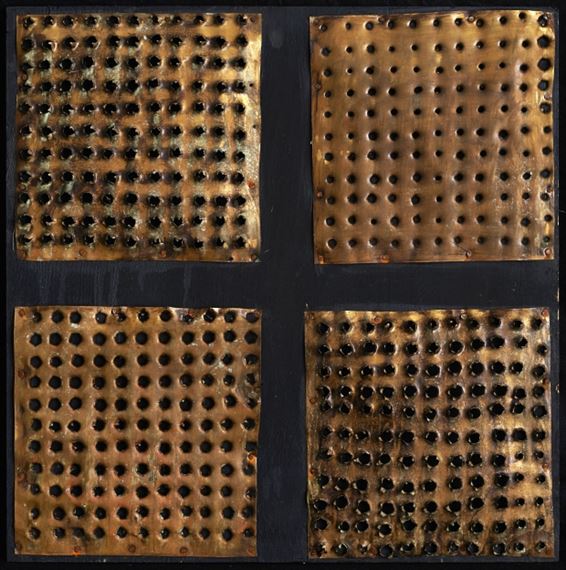Mathias Goeritz: Metachromatic
During the second half of the 1950s, while living in Mexico, German-born art historian and artist Mathias Goeritz began the production of a series of works that, with time, became known as Mensajes (Messages). The first pieces of this series consisted of old and used fragments of scrap metal that were perforated, nailed and adhered to different wooden surfaces. Some of these supports were painted and their colors could be seen through the holes in the metal sheets. AlthoughMensajes is the definitive name given to this group of works, Goeritz originally referred to them as clavados (nailed) and sudarios (shrouds), two names that are explicit of the religious intent that the artist wanted to give to this series. Shortly after he began executing these nailed and perforated pieces, he also embarked on the production of other works for the series that are characterized by their monochromatic golden surfaces. He referred to these works, covered with gold leaf, as Mensajes metacromáticos (Metachromatic messages) as they carried a “meaning” beyond the presence of color. For the artist, these messages were representations of nothingness and the absolute; through the luminosity of the gold leaf he sought to actualize a traditional relation between spirituality and light.
The Messages are part of a larger redefinition within Goeritz’s artistic and discursive practices that took place during the second half of the fifties. In these years, he also began collaborating in renovation projects of old Catholic churches. For these, he designed modernist stained glass panels that played with light and different colors in order to create chromatic atmospheres – from the traditional amber to a daring blue – within the interiors of the old temples. Goeritz, along other artists and architects like his friend Ricardo de Robina, participated in a radical actualization of religious art and architecture that took in place in Mexico and that anticipated the aesthetic renovations brought by the Second Vatican Council. The artist presented the Messages as modern religious art in line with the epoch. The architect Luis Barragán, for example, bought and commissioned several of these works. The non-objective nature of the pieces made them ideal for his own solutions of modern architecture, as they could integrate with and expand upon the spatial scenes of his constructions. This can be appreciated, for instance, in the Metachromatic Message that Barragán acquired in the 1950s and that hangs above the iconic stairs of his own residence in Mexico City. - Daniel Garza-Usabiaga

Recommended for you
During the second half of the 1950s, while living in Mexico, German-born art historian and artist Mathias Goeritz began the production of a series of works that, with time, became known as Mensajes (Messages). The first pieces of this series consisted of old and used fragments of scrap metal that were perforated, nailed and adhered to different wooden surfaces. Some of these supports were painted and their colors could be seen through the holes in the metal sheets. AlthoughMensajes is the definitive name given to this group of works, Goeritz originally referred to them as clavados (nailed) and sudarios (shrouds), two names that are explicit of the religious intent that the artist wanted to give to this series. Shortly after he began executing these nailed and perforated pieces, he also embarked on the production of other works for the series that are characterized by their monochromatic golden surfaces. He referred to these works, covered with gold leaf, as Mensajes metacromáticos (Metachromatic messages) as they carried a “meaning” beyond the presence of color. For the artist, these messages were representations of nothingness and the absolute; through the luminosity of the gold leaf he sought to actualize a traditional relation between spirituality and light.
The Messages are part of a larger redefinition within Goeritz’s artistic and discursive practices that took place during the second half of the fifties. In these years, he also began collaborating in renovation projects of old Catholic churches. For these, he designed modernist stained glass panels that played with light and different colors in order to create chromatic atmospheres – from the traditional amber to a daring blue – within the interiors of the old temples. Goeritz, along other artists and architects like his friend Ricardo de Robina, participated in a radical actualization of religious art and architecture that took in place in Mexico and that anticipated the aesthetic renovations brought by the Second Vatican Council. The artist presented the Messages as modern religious art in line with the epoch. The architect Luis Barragán, for example, bought and commissioned several of these works. The non-objective nature of the pieces made them ideal for his own solutions of modern architecture, as they could integrate with and expand upon the spatial scenes of his constructions. This can be appreciated, for instance, in the Metachromatic Message that Barragán acquired in the 1950s and that hangs above the iconic stairs of his own residence in Mexico City. - Daniel Garza-Usabiaga
Artists on show
Contact details
















